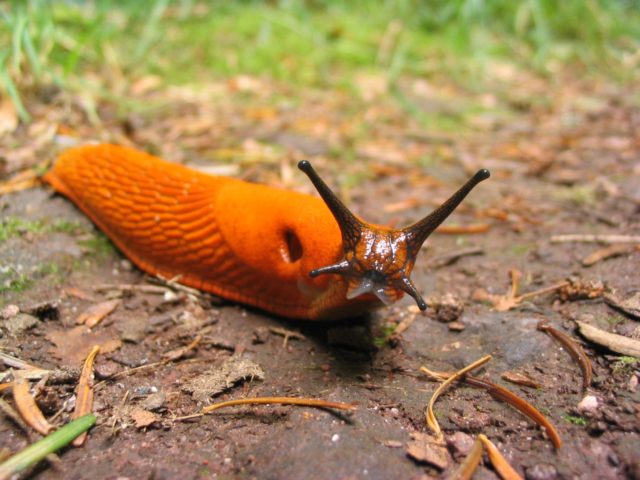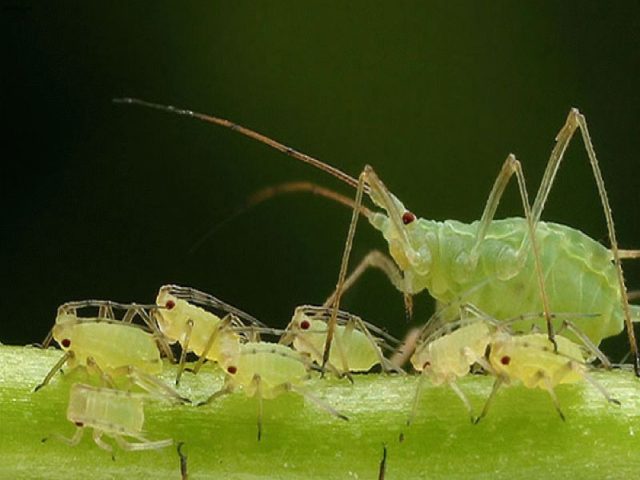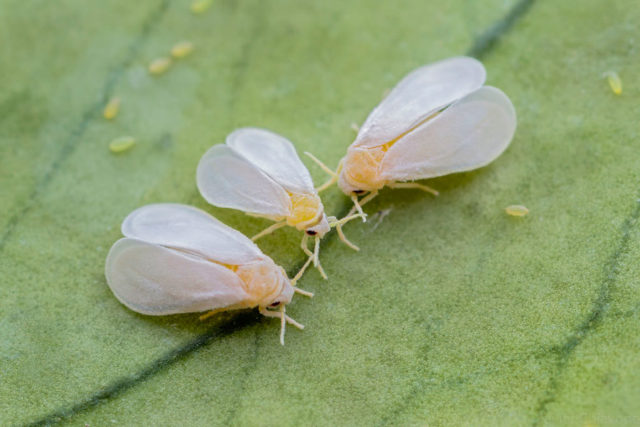Content
Rhodochiton is a perennial vine of the Norichnikov family. In the natural environment, flowers live in the Central regions of America. To grow and develop, the creeping shoots of Rhodochiton need support. Delightful exotic flowers are characterized by long flowering and delicate aroma.

The delicate surface of the exquisite Rhodochiton flower is covered with the smallest villi of an unsurpassed wine shade
Description of colors
Liana Rhodochiton is an amazing representative of the flora world, which is distinguished by the following features:
- shoot length - up to 4 m;
- the shape of the leaves is heart-shaped;
- the color of the leaves is green (in the sun it is purple), with red veins;
- the shape of the inflorescences is a tube up to 2.5 cm long on a flexible peduncle with a five-petal bell;
- inflorescence color - deep burgundy, wine.
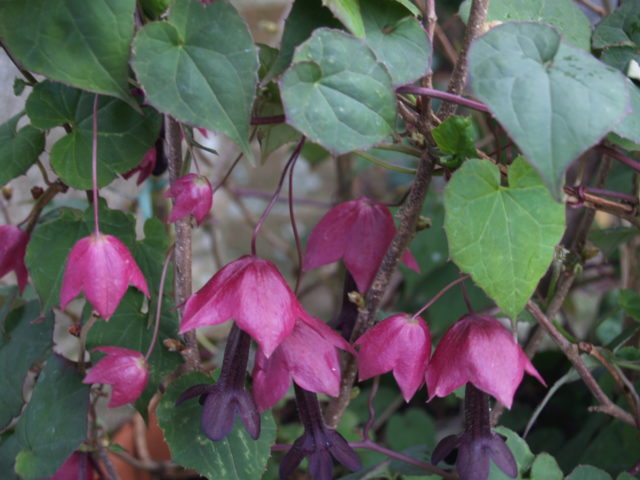
The perianth of Rhodochiton is characterized by a lighter shade and retains its original color throughout the entire long flowering period
How to grow rhodochiton from seeds at home
Growing from rhodochiton seeds (Chinese lanterns, Purple rain and other exotic varieties) is possible at home. In order to cultivate a flower as a houseplant, you can sow seeds at any time of the year. In order to plant vines in open ground, seedlings are sown at the end of February or at the beginning of March.
Algorithm for growing from seeds of Rhodochiton Rhodes, Purple Bell, Ruby Bells and other popular varieties:
- For seedlings, vines choose a low, small box or container with cells.
- The soil for sowing the seeds of Rhodochiton requires loose, nutritious, consisting of equal volumes of garden soil, humus and coarse river sand.
- Rhodochiton seeds are preliminarily kept in a weak (0.5-1%) solution of potassium permanganate for 10 minutes, rinsed and dried.
- Seed material is spread over the surface of the soil using a wooden skewer, toothpick or tweezers, lightly pressed into the ground and sprinkled with a thin layer of sand.
- Crops are moistened with a spray bottle.
- The container with the sown rhodochiton seeds is covered with plastic wrap or glass to create a greenhouse effect.
- For the successful germination of Rhodochiton seeds, it is necessary to maintain a constant temperature up to 24 ° C and daily airing.
- When the first shoots appear (1-3 weeks after sowing the seeds), the container with the crops must be transferred to a room with a lower air temperature (up to 18 ⁰С), which will temper the seedlings and prevent the shoots from stretching upwards.
- After the emergence of shoots, the shelter is removed for several hours, gradually teaching the plant to do without greenhouse conditions.
- Seedlings are dived into pots up to 10 cm in diameter when 2-3 permanent leaves appear.
- For painless rooting of dived seedlings, Rhodochiton seedlings need a slightly shaded place, sparing watering without excessive moisture, with a return to a sunny and bright place after final rooting.
After a few weeks, the root system of Rhodochiton will get stronger, and a larger pot will be needed for indoor culture.
When planting seedlings in open ground, it may take about 2 weeks to harden the vine seedlings. Rhodochiton is planted in well-moistened holes along with a lump of earth, providing a sufficient distance between individual bushes.

Direct rays of the sun can cause burns on the delicate sprouts of Rhodochiton, therefore it is not recommended to place containers with seedlings on the south side.
How to care for indoor plants
Caring for indoor rhodochiton does not differ in exotic requirements. It is enough to provide the plant with high-quality soil, a comfortable pot, choose the right microclimate, watering and feeding regime.

With proper care, indoor Rhodochiton pleases for a long time with the flowering of magical and alluring inflorescences of fabulous beauty
Lighting
Indoors, the Rhodochiton will be most comfortable in the depths of a bright and spacious room with a sufficient level of sunlight. The best option is to place a container with a vine on the windowsills of windows facing west and east.
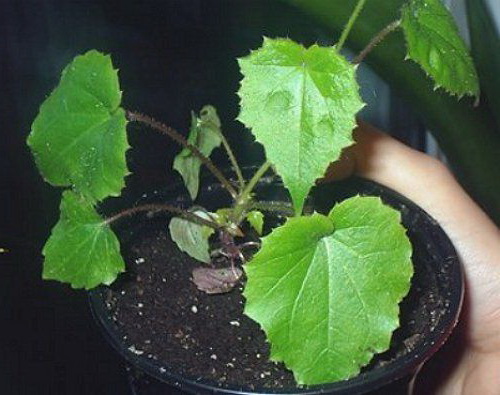
Indoor Rhodochiton prefers bright lighting
Pot and soil
For indoor vines, you should choose volumetric pots or flowerpots with a diameter of more than 20 cm. For plants, fertile, air and permeable soil with drainage is suitable.

For Rhodochiton flowers, a loose soil rich in organic matter is of particular value.
Fertilizers
As an additional top dressing, mineral fertilizers with a high phosphorus content are suitable for home crops. It is necessary to fertilize the plants once every 2 weeks.

There is no need to feed Rhodochiton flowers in winter.
Watering and soil moisture
The indoor vine should be watered regularly, avoiding stagnant water. Tropical culture requires constant maintenance of high air humidity. Regular spraying, use of humidifiers, placing an aquarium near a vine or a container of water are ideal conditions for a Rhodochiton to live indoors.
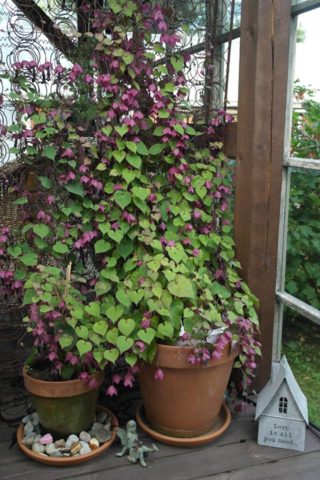
In autumn and winter, watering rhodochiton flowers is reduced
Bloom
Since Rhodochiton is a type of tropical liana, the plant cannot grow and develop without support. In indoor conditions, you should take care in advance of what can serve as a support for creeping shoots.
Indoors, the tropical liana blooms mainly in the summer, but even in winter it can produce single flowers.
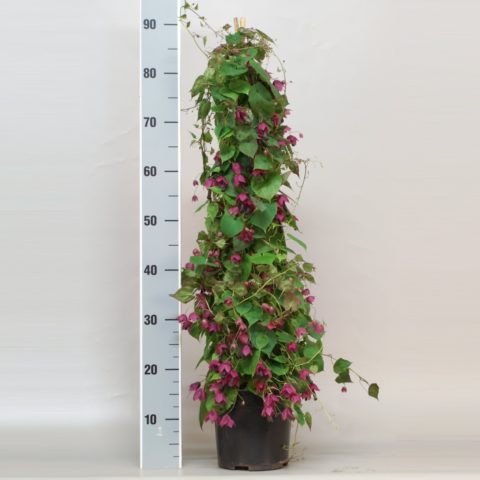
Rhodochiton flowers are bisexual, they form an ovary with seeds
Caring for rhodochiton in the garden
Garden vines are a delightful decoration of the local area. With proper care, Rhodochiton blooms without pause for almost the entire season, illuminating the territory with an alluring wine shade of unusual inflorescences.
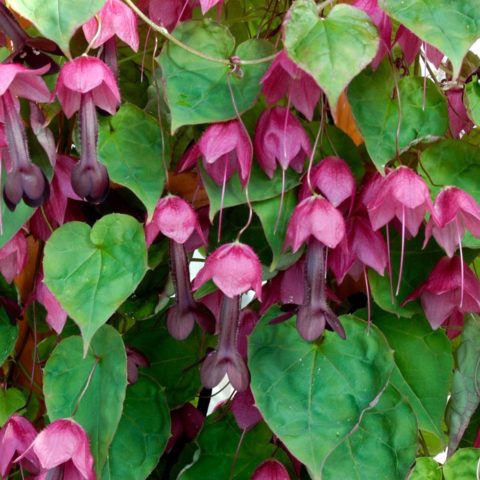
Rhodochiton - an exquisite choice of modern landscape designers
Where to plant
To obtain the effect of abundant flowering, the culture requires constant natural sunlight throughout the day. Exceptions to the rules are the placement of creepers in a small partial shade of trees and buildings.
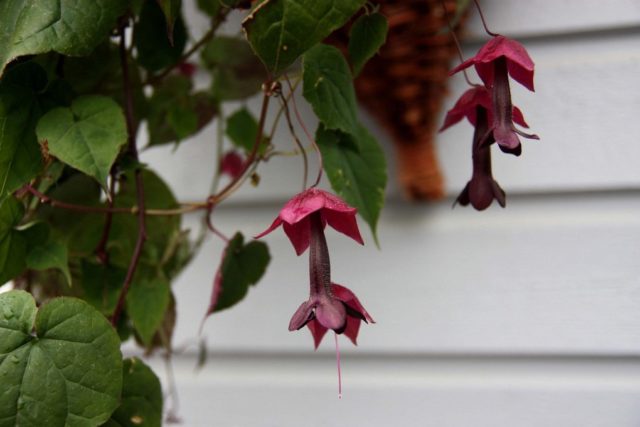
Rhodochiton is a light-loving culture, so plants should be planted in open, well-lit areas.
The soil
For rhodochiton flowers, as for any tropical plant, a sufficiently fertile, air and permeable soil with an effective drainage system is required.
For horticultural crops, you should choose a slightly acidic soil rich in humus. A swampy, heavy area is categorically unacceptable for culture.
When transplanting seedlings into open ground, humus is introduced into the hole to make the soil more fertile.
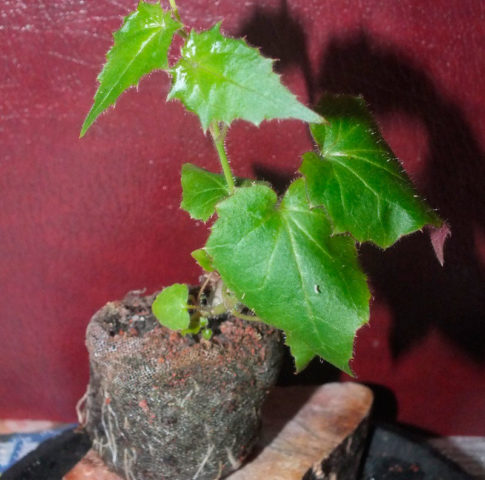
Soil pre-fertilized before planting flowers does not require special fertilization during the entire growing season
Fertilizers
For the normal growth and development of a tropical liana, periodic fertilization with complex mineral preparations with a maximum phosphorus content is necessary. Fertilization terms - 2 times a month.
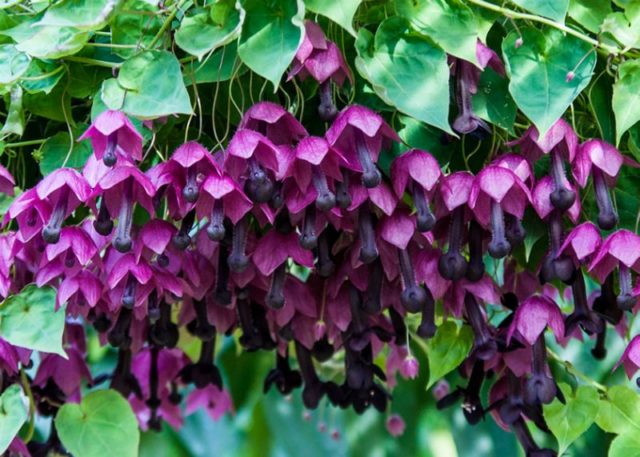
Flowers bloom most abundantly in the soil, pre-fertilized with preparations with a predominance of phosphorus, since the increased nitrogen content stimulates the forcing of shoots and the formation of foliage
Watering
Rhodochiton needs regular watering. The plant needs the soil around the liana bush to be kept sufficiently moist, but without stagnant water. During the dry summer, flowers need additional, more abundant watering.
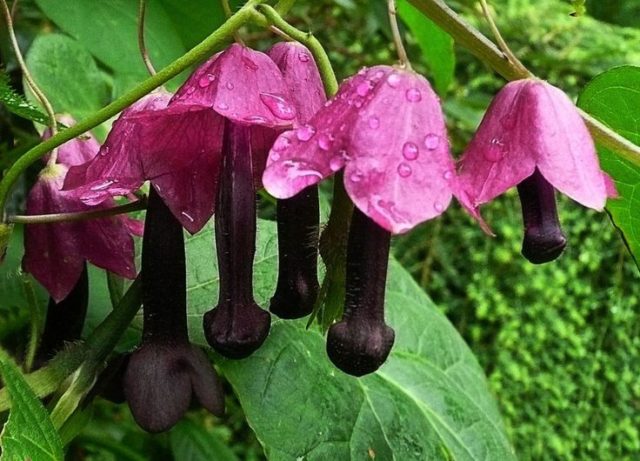
Dry air provokes the process of leaf fall
Flowering period
Under favorable environmental conditions, the first inflorescences of Rhodochiton bloom in June-July. The bud opens gradually, revealing an exotic 5-petal bell with pointed petal tips, which are shaped like a Chinese lantern.
The flowering period is all summer, during which the perianths remain on the flowers.
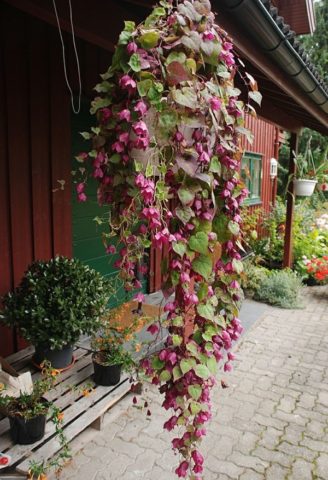
With the onset of the first cold weather and with a decrease in daylight hours, the thermophilic liana completes flowering
Reproduction
Tropical flowers reproduce in two ways:
- seminal (by sowing seedlings);
- vegetative (using cuttings).
Rhodochiton seeds are sown for seedlings in late winter or early spring for subsequent transplantation in open ground.

For growing vines in indoor conditions, sowing seeds can be done at any time.
Propagation by cuttings is carried out in autumn or spring. Cut shoots of Rhodochiton are rooted in nutrient soil in greenhouse conditions with periodic ventilation. Autumn cuttings are transferred for wintering indoors. Spring plants are to be transplanted into open ground.
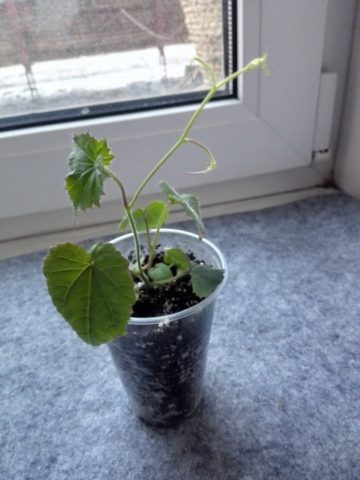
Flowers grown from cuttings develop quickly and begin to bloom
Pruning
Rhodochiton bloom begins in summer and ends in autumn. In the spring, before the beginning of the flowering period, and in the fall before wintering, the vine should be cut off (remove 1/3 of the length of the shoots that can be rooted as cuttings).
In addition to seasonal pruning, the apical buds of flowers need regular pinching. This will form a lush and dense bush.
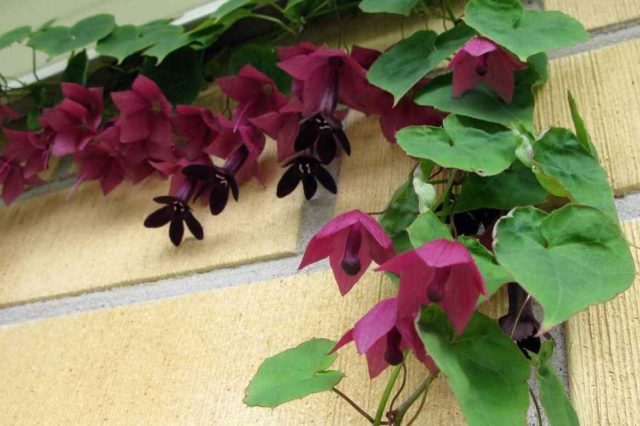
A sanitary "haircut" is carried out with a sharp, sterile garden tool as needed
Wintering
Tropical plants do not tolerate a drop in ambient temperature below + 10 ⁰С. For wintering, the garden liana is transferred to the room. The optimum temperature for wintering Rhodochiton is up to 18 ⁰С. During this dormant period, the plant needs reduced watering and reduced daylight hours (up to 14 hours).
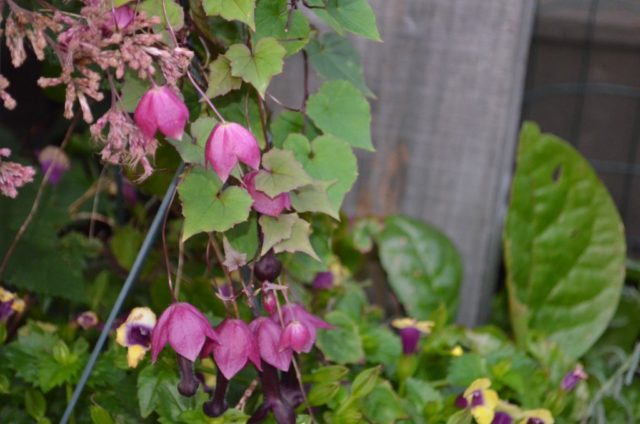
If the flowers are grown as a perennial, the plant is transplanted annually in the spring into open ground after wintering indoors.
Diseases and pests
Excessive dryness of the air in rooms where an indoor flower grows can provoke leaf fall. The tips of the leaves dry up, gradually die off and crumble. To prevent such a phenomenon, the basic rules for watering and humidifying the air for a tropical indoor culture should be observed.
In addition, rhodochiton can become infected with a disease such as mildew (downy mildew), the causative agent of which is the peronospore fungus Plasmopara viticola from the oomycete class.
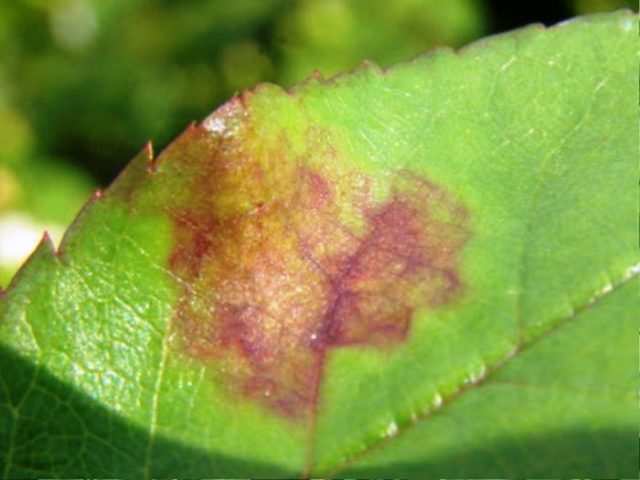
To combat the disease, the affected leaves are removed, the plant is treated with insecticide solutions
Outdoor plants can attack such pests:
- Slugs - gastropods, which destroy leaves and shoots, cause irreparable damage to plants.
Manual collection of slugs is used as a natural pest control measure.
- Aphid - the smallest insects that inhabit the Rhodochiton in huge colonies. Pests suck juices, as a result, the culture weakens, foliage and inflorescences are noticeably deformed. If aphids are found, the vine should be treated with insecticide solutions.
As folk methods of combating aphids, you can use the infusion of nettle, wormwood, onion, tobacco, dandelion
- Whitefly shows its presence on flowers by the presence of small light dots on the leaves, followed by yellowing and foliage falling off.For spraying plants, chemicals and insect traps are used.
An effective measure to combat the whitefly butterfly are folk remedies: tinctures of tobacco, garlic, wormwood, soap solutions
Conclusion
Like all tropical vines, Rhodochiton is fast growing. By sowing seeds for seedlings in March, you can already at the beginning of June get a magnificently flowering plant, which decorates any obstacle (fence, wall, fence, arch, tree) with creeping stems and an abundance of green foliage.
